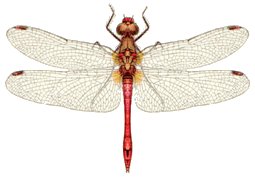| Sympetrum
sanguineum |
 |
|
Common Name:
|
Ruddy Darter |
|
Odonata |
|
Order:
|
Odonata |
|
Suborder:
|
Anisoptera |
|
Family:
|
Libellulidae |
|
Genus:
|
Sympetrum |
|
Species:
|
S. sanguineum |
|
|
| The
Name |
| Sympetrum sanguineum (Muller, 1764),
the Ruddy Darter, is a European species of dragonfly of the family Libellulidae.
This species is most likely to be
confused with the Red-veined Darter (Sympetrum fonscolombei) and the Common
Darter (Sympetrum striolatum) however the latter is more orange-red and
has a straight sided abdomen and yellow stripes on the legs, while for
Ruddy Darter, the legs are all black. Female Ruddy Darters are similar
to female Black Darters (Sympetrum danae) however in the former there is
no black triangular marking on the thorax.
|
| The
Characteristics |
| This species is smaller than the
Common Darter, and usually has a length of 34-36mm, attains a wingspan
of up to 6 cm. The legs are entirely black. An intense orange colouration
can be seen only at the very base of the wings. The pterostigma is brown.
There are usually two prominent black marks on S8 and S9.
The male have the head, thorax and
abdomen vivid red, and become blood-red with maturity with a red frons
and red-brown thorax. There is a very noticeable constriction of the abdomen
around S4, giving a club-shaped appearence.
Females are slightly smaller, have
a golden-yellow colour with black markings. The abdomen widens for the
final third of its length and shows a marked pinched section where it joins
the thorax. There is no red panel on the side of the thorax. Older females
may develop some red along the midline and segment boundaries of the abdomen.
|
| The
Reproduction and Development |
| Adults perch on edge of open spaces
when feeding. Mature males occupy perches near breeding sites and defend
small area around them. Perches often changed if no females encountered.
Females are intercepted as they approach breeding sites and taken in tandem
by males to bushes for copulation.
Mating takes place on the wing, with
the coupled pair performing a dipping flight over the water. The female
jettisons her fertilised eggs at the water surface by alternating movements
of the abdomen. The male will hover nearby during this period and protect
the female by driving off any approaching males. Females oviposit usually
when in tandem with male, over open water, clumps of plants or exposed
muddy margins by dipping abdomen on water surface to wash off batches of
eggs.
Eggs either hatch within a few days
of laying, or if laid late in season eggs will diapause until spring. Larval
development takes one year beneath the water surface. Larvae live amongst
roots of aquatic plants including Typha and Equisetum. Emergence on vertical
plant stems in early morning.
Preferred environment are shallow
well-vegetated lakes and ponds often in woodland. In Ireland associated
with pools in fens and cutover bogs, small base-rich mesotrophic lakes
and turlough-like lakes. Flight period from mid June to mid October.
|
| The
Distribution |
The Ruddy Darter is to be found
in southern and central Europe to southern most Fennoscandia, and to western
Siberia. Absent from most of Mediterranean islands, southernmost Iberia
and Italy. Very local in north Africa.
|
| The
Protection Status |
| Its conservation status is regarded
as secure, and indeed numbers seem to be increasing in some locations such
as central England. |
|
References:
http://en.wikipedia.org/wiki/Ruddy_Darter
http://www.habitas.org.uk/dragonflyireland/5650d.htm
|
The
Species on Stamps |
|
|
|
|
|
|
Home | Country
List | Species List
|